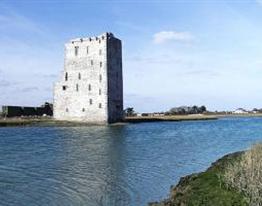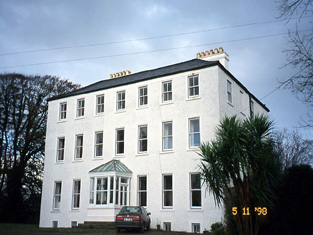Aghangran House
Houses within 10km of this house
Displaying 25 houses.
Houses within 10km of Aghangran House
Displaying 25 houses.
| House name | Description | |
|---|---|---|
| Ballyline | St. John Blacker was leasing this property to Nicholas King at the time of Griffith's Valuation, when it was valued at £3 10s, on a holding of over 250 acres. Modern farm buildings exist at the site now. [Grid Reference is approximate]. | |
| Carrigafoyle Castle | Charles L. Sandes was leasing this property to Stephen Sandes at the time of Griffith's Valuation, when it was valued at £19 10s. It is described on the 1st edition Ordnance Survey Map as Carrigafoyle Castle but on the later 25" edition as Carrigafoyle House. In 1786 Wilson refers to it as "the ancient mansion of O'Connor Kerry, formerly a place of great strength and important.. but now serving as a store to transport goods from the adjacent places to Limerick". |

|
| Killelton House | Charles L. Sandes was leasing this property to William Hickie at the time of Griffith's Valuation, when it was valued at £33. Bary writes that this Hickie family were originally from Tulla, county Clare, but moved here after the Cromwellian confisciation of the 1650s. They remained in possession of the property until the 1920s. The Irish Tourist Association survey mentions that it was formerly the home of the Higgins-O'Connor family but by the 1940s was in poor repair. The original house is now a ruin. | |
| Letter House | John Wren was leasing this property to Alicia Wren at the time of Griffith's Valuation, when it was valued at £13. Lewis records it as the seat of G. Wren in 1837. In 1814 Leet refers to Litter as the residence of John Wren. Bary writes that Letter was originally a Blennerhassett property which passed to the Wren family through marriage., It is still extant and owned by descendents of that family. | |
| Rushy Park or Rusheen Park | At the time of Griffith's Valuation, Rev. Samuel Leonard was leasing this property to Thomas O'Connor, when it was valued at £9 15s. Bary writes that this house was in the Leonard family in the early nineteenth century. It was demolished in the early twentieth century and a new house constructed at the site. | |
| Jane Mount | Pierce Mahony's estate was leasing this property to Jeremiah Dillane at the time of Griffith's Valuation, when it was valued at £7 5s. Bary states that the house is believed to have been built by Gun Cunningham in the eighteenth century. It passed through marriage to the Mahony family. The Dillon family have been in possession of the property since before the Famine. The original house is now ruined. | |
| Garryard | Thomas Dillane was leasing this property from the Mahony estate at the time of Griffith's Valuation, when it was valued at £5 10s. Bary states that the house is alleged to be over 300 years old and originally the property of the Newman family. In the eighteenth and early nineteenth century it was held by the Enright family and later passed to the Bolster family through marriage. It served as an auxilliary work house during the Famine and was also the location of the local creamery. It is still extant and occupied. | |
| Coolard House | At the time of Griffith's Valuation, Samuel Raymond, MD, was leasing this property to Patrick Dalton, when it was valued at £10 5s. A house still exists at the site. | |
| Tullamore House | Sir John Benn-Walsh was leasing this property to Laurence Buckley at the time of Griffith's Valuation, when it was valued at £12 10s. In 1814 Leet refers to it as the residence of Mrs. Julian. Wilson writing in 1786, mentions Tullamore as the seat of Rev. Mr. Julian. In 1837 Lewis noted it as the seat of C. Julian. Bary writes that it was a house mostly associated with the Julian family. It was derelict at the end of the twentieth century. | |
| Pyrmont House | Wilson refers to "Fyrmont" as the seat of George Leake in 1786. In 1837 Lewis recorded this house as the seat of W. Sandes. At the time of Griffith's Valuation, the representatives of Lord Hallyburton's estate were leasing this property to William Sandes, whom Bary describes as the most "fair-minded" of the Sandes family and a noted horseman. The house was valued at £13 10s at the time. Prymount was included in the sale of the Gun Mahony estate in 1856 when William Sandes was recorded as the tenant from year to year. It later passed to the Sandes of Swallowglen and was subsequently demolished. | |
| Woodlands or Aghana | Robert Leslie was leasing this property to Pierce Leslie at the time of Griffith's Valuation, when it was valued at £8 15s. Lewis records it as the seat of Pierce Leslie in 1837. Bary notes that Robert Leslie was reared by Pierce Leslie, the owner of this property, when he succeeded his father at a young age. The house seems to have been known at times as Aghana House and is still extant and occupied | |
| Tarbert House | Tarbert House was owned by Robert Leslie at the time of Griffith's Valuation when it was valued at £24 10s. Both Leet in 1814 and Lewis, in 1837, note it as the seat of R. Leslie. In 1906 it was valued at £25. The National Inventory of Architectural Heritage suggests the house was built c.1720. In 1786 Wilson describes it as "happily situated on an eminence commanding an extensive view". The house has remained in the Leslie family since that time though the estate was sold to the tenants c.1904. It is open to the public during the summer months. |

|
| Sallowglen | William Sandes was leasing this property to Thomas Sandes at the time of Griffith's Valuation, when it was valued at £24. Lewis notes it as the seat of T.W. Sandes in 1837 as does Leet in 1814. Wilson, writing in 1786, refers to "Sallow Glin, the new and handsome house of William Sandes". In 1906 it was the property of Thomas W. Sandes and valued at £50. Bary writes that it was resided in by the Sandes family and their descendents until the 1920s when the estate was sold. It has since been demolished. | |
| Leslie Lodge or Shanaway | Pierce Mahony was leasing this property to James Patterson at the time of Griffith's Valuation, when it was valued at £12. Wilson refers to it as a seat of Robert Leslie in 1786. In 1814 Leet refers to Leslie Lodge as the residence of John Parker. Lewis, in 1837, records the purchase of the property by Col. D.G. Halliburton In 1856, it is included in the sale of the estate of George Phillip Gun Mahony, a minor, when it is described as untenanted. In 1906, Stephen Collis owned a property at Shanaway East, valued at £6. It is no longer extant. | |
| Tieraclea Lodge | At the time of Griffith's Valuation, Tieraclea was occupied by Stephen Collis, when it was valued at £42. An extensive farmyard is recorded here on the First Edition Ordnance Survey map. The house is labelled as Tieraclea on the later 25-inch map and by 1906 Tieraclea was valued at £45. Bary writes that it had been a residence of the Collis family since the eighteenth century and they continued there until the 1920s. In the early years of the twentieth century the house was destroyed by fire but was re-built and is still extant. | |
| Farranawana House | At the time of Griffith's Valuation, this property was being leased by St. John Blacker to the trustees of Glin Poor Law Union, as an auxilliary workhouse. By 1895 it is labelled on the Ordnance Survey map as Farrawanna House. A house and farm buildings are still extant at the site. | |
| Dromin House | James Raymond was occupying this property at the time of Griffith's Valuation, when it was valued at £17 5s. In 1837 Lewis noted it as the seat of James Raymond while in 1814, Leet refers to it as the residence of James W. Raymond. In 1786 Wilson had also noted it as a seat of the Raymond family. In 1906 it was owned by the representatives of James Raymond and valued at £17. Bary states that this property was originally associated with the Fitzmaurice family, Lords Kerry, but that it passed to the Raymond family in whose possession it remained until the mid-twentieth century. It is still extant and occupied. | |
| Aughrim | At the time of Griffith's Valuation, Rev. R. Fitzgerald was leasing this property from the Blacker estate when it was valued at £6 and part of a holding of 600 acres. It is described as a Steward's house. Farm buildings still exist at the site. | |
| Moyvane Farm | At the time of Griffith's Valuation, William Sandes was leasing a property to Stephen Sandes at Moyvane North, valued at £3 5s, on a holdings of 150 acres. It is described as a farmhouse. | |
| Moyvane House | William L. Vesey-Fitzgerald Foster was leasing this property from the TCD estate at the time of Griffith's Valuation, when it was valued at £3 15s. In 1837 Lewis mentions the principal residence in Murher parish as the property of Baron Fitzgerald but occupied by Mr. Enright. In 1814, Leet refers to it as the residence of John Sandes. Bary notes that it was earlier associated with the Sandes family. It is no longer extant. | |
| Gunsborough | At the time of Griffith's Valuation, this was the property of Pierce Mahony and valued at £12 10s. It was leased to Listowel Board of Guardians as an auxilliary workhouse. In 1837 Lewis records it as the property of Pierce Mahony who had recently purchased the estate. Bary writes that it had previously been in the possesson of the Gun family. It is now ruined. | |
| Bedford House | Wilson refers to Bedford as the seat of Colthurst Bateman in 1786. In 1837 Lewis mentions Bedford House as the seat of S.S. Raymond.At the time of Griffith's Valuation, it was being leased by Samuel Raymond to Listowel Board of Guardians as an auxilliary workhouse and was valued at €25. Bary notes that this house was associated with the Bateman family and may have been built for the marriage of Colthurst Bateman in 1775. It is now a ruin. | |
| Cahirdown | In 1906 Denis Gun Browne owned a house valued at £20 at Dromin Upper, barony of Iraghticonnor. At the time of Griffith's Valuation, this had been been part of Rev. George Browne's estate, let to the Collins family, though the house was then valued at £1 10s. It is labelled Cahirdown on the 1895 map. | |
| Shannon View (Tarbert) | At the time of Griffith's Valuation, Richard Hinde held a farmhouse at Coolnanoonagh, valued at £2 15s. A house labelled Shannon View appears at this location on the 25-inch edition Ordnance Survey map, published in the 1890s. A house is still extant at the site. | |
| Rusheen House | In 1786 Wilson refers to Rusheen as the seat of Mr. Crosbie. The 1st edition Ordnance map of the townland shows both Rusheen House and the site of "Rusheen Old House". At the time of Griffith's Valuation Stephen Sandes was leasing this property from the Crosbie estate. It included a herd's house valued at £1 5s. Bary writes that there were several marriages between members of the Crosbie and Sandes families in the eighteenth and nineteenth centuries. The house is no longer extant. |

